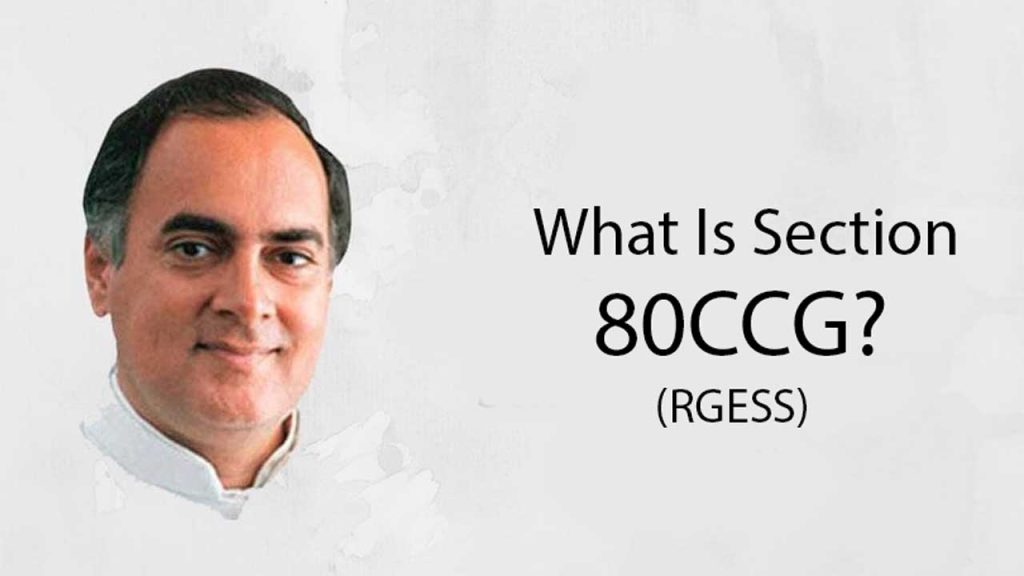Section 80CCG – Investing in the share market is a vital method to raise capital. The Government has adopted various schemes that promote people to make investments and permit specific methods that minimize the risk associated with the investment. The Government implemented the Rajiv Gandhi Equity Saving Scheme (RGESS) to motivate retail firms to invest in shares and mutual funds. RGESS authorizes an exemption under Section 80CCG for investments throughout equity as well as mutual funds.
Investments are produced throughout the stock market, commodity market, or bond market, both of which reflect the combination of stock buyers and sellers reflecting company ownership statements. These could also cover securities listed on a public stock exchange, along with private-traded stocks. The equity market is the place in which, either via exchanges or over-the-counter markets, securities are traded as well as issued. This market offers employees a way to increase the required amount of capital and also provides investors with the option to obtain by letting the stock shares of those firms to be traded.
According to the historically prevalent Section 80C, Section 80CCG provides for larger deductions than Rs. 1,50,000. For persons making higher contributions, the scheme is incredibly beneficial. The exemptions will be claimed at the period that the taxpayer files income tax returns.

In the Finance Act 2012, Section 80CCG was adopted and became part of the Income Tax Act. The Rajiv Gandhi Equity Savings Scheme is another term for this section (RGESS). Although the idea was to boost current investors’ investing habits and attract first-time investors, it also aimed to enhance the stock market’s investment force. The Government thus intended to target many socio-economic factors through this one policy, such as fostering the habit of savings, widening the reach of capital markets outside retail investors, widening the consumer base and creating a culture of stock trading among all the popular masses.
The RGESS scheme was alerted by the Department of Revenue on 23 November 2012, and the resulting correction was subsequently released on 5 December 2012. SEBI (SEBI) released its operating guidance on the very same day. More changes were finally introduced to expand the reach of the scheme by the Finance Act, 2013. Notification of the amendment was given on 18 December 2013.
Individuals entitled to receive the RGESS benefit
Now let’s first consider our interpretation of a “new investor” before addressing the qualifying conditions for the advantages of this program. A new investor is one of the residents who did not open a Demat account or were unable to trade in the stock and derivatives section. There are many other occasions where a group of people as joint account holders share their part. The first account holder is not known to be a “new investor” in this kind of situation. If you buy shares in unregistered firms or those purchased under the Company Equity Option Scheme, you will still not be deemed a new owner (ESOP).
Main Features of Section 80CCG
- Only individuals may request the income tax deductions under Section 80CCG for their savings. This cannot support all other organisations and businesses. HUFs (Hindu Undivided Family) or BOI (Body of Individuals) are not asserted as the beneficiary groups to this program. This should be clearly stated that if you remain out of India, the person must definitely be a resident of India and therefore can not assert the advantages.
- The overall profits of the participant who is a member of such a policy must be 12 lakhs for the current or appropriate FY in which the investment is made.
- The RGESS claimant must remember that there is a 3-year lock-in cycle for investment under Section 80CCG. Although the first year is a set lock-in duration, the following 2 years have a variable lock-in duration.
- The owner is forbidden from offering market shares during the first year of the lock-in that year. That being said, the shares may be sold off somewhere in the 2nd and 3rd years, which will become a versatile lock-in phase.
- Also during the flexible lock-in era, investors attempting to sell the shares will be allowed to re-invest in each of the qualifying shares in just such a way that they sustain their level of investment over the 2 years at the same rate that they received the income tax deduction under Section 80CCG. Instead, they are recommended to retain their level of investment at the valuation of the portfolio.
Deductions allowed in RGESS
If a person puts his or her money in the RGESS, the tax gain credit is 50 per cent of the overall amount spent, equivalent to a maximum contribution of Rs. 50,000.
This criterion can be viewed using a variety of examples-
- If the sum of money invested in RGESS is Rs 50,000, which may be the highest limit allowed, the deduction would be Rs 25.000, that is 50% of the sum invested.
- If the sum invested in Rs 90,000 is Rs 50,000 and the highest limit authorized is Rs 50,000, the deduction shall be considered from the maximum amount of Rs 50,000 and the reduction shall again be 50 per cent of Rs 25.000. The excess number will also be zero when the reduction is counted which would be quite a loss of investment.
- If the amount invested in Rs 20,000 would be less than the cap amount of Rs 50,000, the overall qualifying contribution will be Rs 20,000 and the deduction would be determined as 50% of that amount, that will be Rs 1,000.
Conclusion
Section 80CCG or RGESS continued to foster an ‘equity mentality’ in such a manner that people have the scope to save their taxes by investing in the equity or stock market. There are so many special aspects of the scheme that have made significant progress for the economic stability of the citizens, and the need for the government to succeed on the stock exchange. There are indeed a few complexities in the scheme involving the treatment of shares issued in a variable lock-in phase, and a clear clarification can be taken from the RGESS FAQs published by the Ministry of Finance on 5/2/2014.



